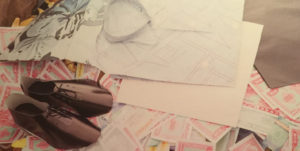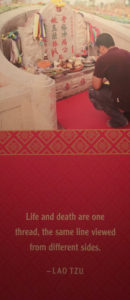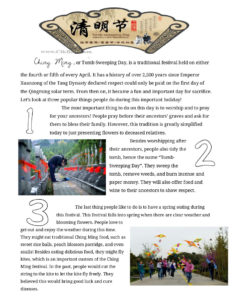Ching Ming
Ching Ming, Grave-Sweeping Day, is usually observed on April 4th or 5th.
The date is indicated on the Chinese calendar with the two characters: ching, meaning pure or clean, and ming, meaning brightness. Combined together, Ching Ming means clean and just. This date is also indicated on traditional Japanese calendars, where their culture has a similar observance. In Korean culture, the observance is known as Hansik.
The Ching Ming observance may have had its beginnings as the original religion in China. Ancestor worship is the only native religion to China. All others, including, Buddhism, Christianity, Judaism, and Islam, were imported from outside of China. Confucianism and Taoism originated in China but are philosophies rather than religions. In the philosophy of Confucianism, a form of ancestor worship is incorporated with the virtue of filial piety.

Ching Ming rituals not only include weeding of the area, cleaning of the headstone, and replacing the wilted flowers with fresh ones, but also the lighting of incense and burning of imitation paper money. The burning of the imitation money is for the deceased to use in the afterlife. One year while visiting in China, one of my uncles from Canada even purchased a paper facsimile of a pair of eyeglasses and camera in Hong Kong to burn as part of the offerings; and an aunt in Hong Kong lit a cigarette at the end of a twig to make as an offering.

In addition, food is laid out in front of the headstone as an offering to the spirits of the deceased. The food may include a steamed whole chicken (including the head, which is later twisted off), hard boiled eggs cut in half lengthwise with shell attached, sliced barbecued pork (cha shiu), cut roast pork with crunchy skin attached, and dim sum pastries. In addition, three sets of chopsticks and three Chinese wine cups are arranged above the food and closest to the headstone.
The head of the household usually begins by bowing three times with the wine cup in hand, then pouring the wine on the ground just in front of the headstone. This procedure is usually repeated three times. Each member of the family comes in front of the headstone and bows three times with the right fist held cupped in the left hand. Some families will then eat the food together there at the gravesite, similar to having a picnic with their deceased relatives. It is said to bring good luck to eat the food that was offered to the deceased.
In addition, some families will begin by setting off firecrackers to scare off evil spirits and to alert the deceased relatives that they are there to pay their respects.
Today, the responsibility to hang san or ’walk the mountain’ as visiting the cemetery is commonly known, still falls to the eldest son. Today families may be more likely to prefer simplified offerings of only the incense, paper money and flowers.
By Don S. Gee
In response to a question regarding gravesites, Don responded:
In the U.S., we just follow western custom for the burial plot and headstone. The headstone may include bilingual information with the Chinese text including not only the name, but also village, area, county, province of birth.
I’ve seen my relatives’ gravesites in China. The site is first chosen for the best feng-shui. Then instead of a headstone, the stone is usually placed at the foot and is usually a small tablet indicating name, date of birth and death. Since most Chinese are usually buried near where they were born and raised, I don’t remember seeing that information on the tablet, but I may be wrong. In front of the tablet is an area used to place the incense, usually three holes or an actual brass incense urn. There is a rectangular cove where the tablet sits, and the walls on either side are shaped circular and decreasing in height as towards the front. The floor area in front of the tablet and between the “walls” are flat. All this is made with cement. The floor area is flat so that the family can make the food offerings during Ching Ming (in April) and Chung Yeung (in October), both during the full moon or a few days to a couple of weeks earlier if it is more convenient for the family.
By Don S. Gee


